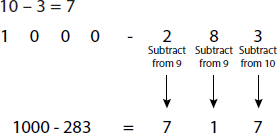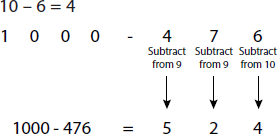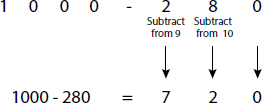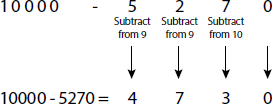Subtraction
In This Chapter
![]()
- Subtracting left to right
- Subtracting from powers of 10
- Learn subtraction by the all from 9 and last from 10 method
Generally speaking, subtraction is considered to be difficult because of the carryovers and the concept of borrowing. Even though you deal with subtraction early on in your student life, you may still have a kind of mental aversion to it as you grow up.
In this chapter, I show you some shortcuts to get answers to subtraction problems. Soon, you won’t mind subtracting at all!
Unlike the traditional system of subtraction, which goes from right to left, subtracting from left to right helps you deal with carryovers in a faster and easier fashion.
Example 1
Solve the problem 724 − 261.
Step 1: Subtract the first column: 7 − 2 = 5.
Step 2: Subtract the second column. Because 2 is less than 6, you reduce the answer in the first column by 1, changing 5 to 4. You then place that carryover 1 with the second column, which changes 2 to 12, and subtract: 12 − 6 = 6.

Step 3: Subtract the third column: 4 − 1 = 3.
Solution: The answer is 463.
QUICK TIP
In subtraction, one common problem you’ll run into is the top number being smaller than the bottom number. In such cases, you go back one step, reduce the number in the previous column by 1, and carry over the 1 to the current step.
Solve the problem 647 − 294.
Step 1: Subtract the first column: 6 − 2 = 4.

Step 2: Subtract the second column. Because 4 is less than 9, you reduce the answer in the first column by 1, changing 4 to 3. You then place that carryover 1 with the second column, which changes 4 to 14, and subtract: 14 − 9 = 5.

Step 3: Subtract the third column: 7 − 4 = 3.

Solution: The answer is 353.
Example 3
Solve the problem 4,247 − 1,763.
Step 1: Subtract the first column: 4 − 1 = 3.

Step 2: Subtract the second column. Because 2 is less than 7, you reduce the answer in the first column by 1, changing 3 to 2. You then place that carryover 1 with the second column, which changes 2 to 12, and subtract: 12 − 7 = 5.

Step 3: Subtract the third column. Because 4 is less than 6, you reduce the answer in the second column by 1, changing 5 to 4. You then place that carryover 1 with the third column, which changes 4 to 14, and subtract: 14 − 6 = 8.

Step 4: Subtract the fourth column: 7 − 3 = 4.

Solution: The answer is 2,484.
Subtraction with Numbers Near 10 or a Multiple of 10
Numbers near a base or multiple of 10—such as 9, 19, 28, 38, 47, and so on—are very quick and easy to subtract. All you have to do is round the number up to the multiple of 10 it’s closest to and solve; after that, you add back in the difference.
Example 1
Solve the problem 52 − 8.
Step 1: Change 8 to 10 and subtract.
Step 2: Because 8 is 2 below 10, add 2 back to get the answer.
42 + 4 = 44
Solution: The answer is 44.
QUICK TIP
Don’t forget to add back in the difference between the multiple of 10 and the number you replaced it with.
Example 2
Solve the problem 82 − 49.
Step 1: Change 49 to 50 and subtract.
82 − 50 = 32
Step 2: Because 49 is 1 below 50, add 1 back to get the answer.
32 + 1 = 33
Solution: The answer is 33.
Example 3
Solve the problem 162 − 77.
Step 1: Change 77 to 80 and subtract.
162 − 80 = 82
Step 2: Because 77 is 3 below 80, add 3 back to get the answer.
82 + 3 = 85
Solution: The answer is 85.
Number Splitting
As you learned in Chapter 2, number splitting can help you split a problem in more manageable parts. You can employ this method when subtracting large numbers.
The following examples show you how you can use number splitting to solve subtraction problems with larger numbers.
Example 1
Solve the problem 6,389 − 4,245.
Step 1: Split the problem into two parts by drawing or imagining a line down the middle.
Step 2: Subtract the numbers on the left side of the split: 63 − 42 = 21.

Step 3: Subtract the numbers on the right side of the split: 89 − 45 = 44. Bring the two parts together.

Solution: The answer is 2,144.
Example 2
Solve the problem 6,889 − 1,836.
Step 1: Split the problem into two parts by drawing or imagining a line down the middle.

Step 2: Subtract the numbers on the left side of the split: 68 − 18 = 50.

Step 3: Subtract the numbers on the right side of the split: 89 − 36 = 53. Bring the two parts together.

Solution: The answer is 5,053.
Example 3
Solve the problem 4,468 − 2,286.
Step 1: Split the problem. Here, note that if you split this problem from the middle, you’d have to do 68 − 86, which would give you a negative answer. Therefore, you should split the numbers into more pieces to avoid any negative numbers.

Step 2: Subtract the left portion: 4 − 2 = 2.

Step 3: Subtract the middle portion: 46 − 28 = 18.

QUICK TIP
You can always use what you learned earlier about rounding up to 10 or a multiple of 10 to help you solve the pieces of the number splits. For example, with 46 − 28, you can change the 28 to 30 to solve 46 − 30 = 16. You then add in 2 to get the answer: 16 + 2 = 18.
Step 4: Subtract the right portion: 8 − 6 = 2. Bring the parts together.

Solution: The answer is 2,182.
Subtraction with the All from 9 and Last from 10 Method
For subtraction, I’d like to introduce you to a method called all from 9 and last from 10. This method can be used when the digit on the top row is less than the digit below it. The following examples show how this method is applied in different scenarios.
Subtracting from a Power of 10
To subtract from a power of 10 using the all from 9 and last from 10 method, going from right to left, you subtract every digit except the last from 9. The last digit is then subtracted from 10.
Example 1
Solve the problem 1,000 − 283.
Step 1: Subtract the 2 in the first column from 9.
9 − 2 = 7
Step 2: Subtract the 8 in the second column from 9.
9 − 8 = 1
Step 3: Because the third column is the last column in this number, subtract 3 from 10.

Solution: The answer is 717.
Example 2
Solve the problem 1,000 − 476.
Step 1: Subtract the 4 in the first column from 9.
9 − 4 = 5
Step 2: Subtract the 7 in the second column from 9.
9 − 7 = 2
Step 3: Because the third column is the last column in this number, subtract 6 from 10.

Solution: The answer is 524.
Solve the problem 10,000 − 2,783.
Step 1: Subtract the 2 in the first column from 9:
9 − 2 = 7
Step 2: Subtract the 7 in the second column from 9.
9 − 7 = 2
Step 3: Subtract the 8 in the third column from 9.
9 − 8 = 1
Step 4: Because the third column is the last column in this number, subtract 3 from 10.

Solution: The answer is 7,217.
Subtracting a Number Ending in Zero from a Power of 10
Subtracting from a power of 10 when your other number has a zero at the end is a bit different. In this case, you subtract every digit except the second to last one from 9; the second to last is then subtracted from 10. The 0 is then simply included at the end of the number.
Example 1
Solve the problem 1,000 − 280.
Step 1: Subtract the 2 in the first column from 9.
9 − 2 = 7
Step 2: Subtract the 8 in the second column from 10.
Step 3: Include the 0 from the third column on the end of the answer; this changes 72 to 720.

Solution: The answer is 720.
Example 2
Solve the problem 1,000 − 370.
Step 1: Subtract the 3 in the first column from 9.
9 − 3 = 6
Step 2: Subtract the 7 in the second column from 10.
10 − 7 = 3
Step 3: Include the 0 from the third column on the end of the answer; this changes 63 to 630.

Solution: The answer is 630.
Example 3
Solve the problem 10,000 − 5,270.
Step 1: Subtract the 5 in the first column from 9.
9 − 5 = 4
Step 2: Subtract the 2 in the second column from 9.
9 − 2 = 7
Step 3: Subtract the 7 in the third column from 10.
10 − 7 = 3
Step 4: Include the 0 from the fourth column on the end of the answer; this changes 473 to 4,730.

Solution: The answer is 4,730.
Subtracting When Neither Number is a Power of 10
For a problem setup not involving a power of 10, you have to take some extra steps with this method to get your answer. Also, unlike what you’ve learned for other methods in this chapter, you have to work the problems from right to left.
Example 1
Solve the problem 651 − 297.
Step 1: Subtract the ones column. You can see that 1 is less than 7. To avoid a carryover, you first do the subtraction in reverse: 7 − 1 = 6. You then subtract the sum from 10: 10 − 6 = 4.
QUICK TIP
Let me repeat the process for the first step in the first example, because it takes a little time to sink in. You start with the right column. In this column, 7 is more than 1. Instead of borrowing, subtract in reverse: 7 − 1. This gives you 6.
You now apply the all from 9 and last from 10 method. Because the number in the rightmost column is the last digit, you subtract 10 from the sum to get your answer: 10 − 6. This gives you 4, which is what you write in the ones column.
Step 2: Subtract the tens column. The 5 is less than 9, so start by subtracting in reverse: 9 − 5 = 4. You then subtract the sum from 9: 9 − 4 = 5.

Step 3: Subtract the hundreds column. The 6 is greater than 2, so subtract as you would normally: 6 − 2 = 4. Because you’ve done so many adjustments to the previous digits, you need to subtract 1 from the sum: 4 − 1 = 3.

Solution: The answer is 354.
Example 2
Solve the problem 425 − 168.
Step 1: Subtract the ones column. Because 5 is less than 8, subtract in reverse: 8 − 5 = 3. You then subtract the sum from 10: 10 − 3 = 7.
Step 2: Subtract the tens column. The 2 is less than 6, so first subtract in reverse: 6 − 2 = 4. You then need to subtract 9 from the sum: 9 − 4 = 5.
Step 3: Subtract the hundreds column. The 4 is more than 1, so you can subtract normally: 4 − 1 = 3. Because you’ve done so many adjustments to the previous digits, you need to subtract 1 from the sum: 3 − 1 = 2.

Solution: The answer is 257.
Example 3
Solve the problem 7,643 − 4,869.
Step 1: Subtract the ones column. The 3 is less than 9, so start by subtracting in reverse: 9 − 3 = 6. You next subtract the sum from 10: 10 − 6 = 4.

Step 2: Subtract the tens column. Because 4 is less than 6, subtract in reverse: 6 − 4 = 2. Now subtract the sum from 9: 9 − 2 = 7.

Step 3: Subtract the hundreds column. The 6 is more than 8, so first subtract in reverse: 8 − 6 = 2. You then need to subtract the sum from 9: 9 − 2 = 7.

Step 4: Subtract the thousands column. The 7 is more than 4, you can subtract normally: 7 − 4 = 3. Because of the adjustments to the previous digits, you then subtract 1 from the sum: 3 − 1 = 2.

Solution: The answer is 2,774.
Starting the Method Later in the Problem
Sometimes, you may need to apply the all from 9 and last from 10 method starting in the middle of the sum. This happens when the top number is larger than the bottom in at least the first column of the problem.
Example 1
Solve the problem 7,251 − 2,790.
Step 1: Subtract the ones column. The 1 on top is more than the 0 at the bottom, so you subtract normally: 1 − 0 = 1.

Step 2: Subtract the tens column. Because 5 is greater than 9, subtract in reverse: 9 − 5 = 4. You didn’t have to apply the method to the previous digit, so you subtract this sum from 10: 10 − 4 = 6.

Step 3: Subtract the hundreds column. The 2 is less than 7, so subtract in reverse: 7 − 2 = 5. You then subtract the sum from 9: 9 − 5 = 4.

Step 4: Subtract the thousands column. The 7 is greater than 2, so you can subtract normally: 7 − 2 = 5. Because of all the adjustments you made, you then have to subtract 1 from the sum: 5 − 1 = 4.

Solution: The answer is 4,461.
Example 2
Solve the problem 92,138 − 27,804.
Step 1: In the ones and tens columns, the digits in the top row are greater than those below them. Therefore, you can subtract them normally: 8 − 4 = 4 and 3 − 0 = 3.

Step 2: Subtract the hundreds column. Because 1 is less than 8, subtract in reverse: 8 − 1 = 7. You didn’t have to apply the method to the previous two digits, so subtract the sum from 10: 10 − 7 = 3.

Step 3: Subtract the thousands column. The 2 is less than 7, so subtract in reverse: 7 − 2 = 5. You then subtract the sum from 9: 9 − 5 = 4.

Step 4: Subtract the ten thousands column. Because 9 is greater than 2, you can subtract normally: 9 − 2 = 7. You then have to subtract 1 from the sum due the earlier adjustments: 7 − 1 = 6.

Solution: The answer is 64,334.
Ending the Method Earlier in the Problem
When at least the last column of the problem has a top number that’s greater than the bottom number, you have to finish the method earlier in the problem.
SPEED BUMP
It pays to inspect the problem first before you begin the all from 9 and last from 10 method. You don’t want to automatically start using it, only to realize you began or ended too early. However, if you trip up, just try again—after all, practice makes perfect!
Example 1
Solve the problem 638,475 − 429,763.
Step 1: Subtract the ones and tens columns. In the ones column, because 5 is greater than 3, you can subtract normally: 5 − 3 = 2. The 7 is greater than 6 in the tens column, so you can also subtract this normally: 7 − 6 = 1.

Step 2: Subtract the hundreds column. The 4 is less than 7, so subtract in reverse: 7 − 4 = 3. You didn’t have to apply the method to the previous two digits; therefore, you subtract the sum from 10: 10 − 3 = 7.

Step 3: Subtract the thousands column. Because 8 is less than 9, you need to subtract in reverse: 9 − 8 = 1. You then subtract the sum from 9: 9 − 1 = 8.

Step 4: Subtract the ten thousands column. The 3 is more than 2, so you can simply subtract: 3 − 2 = 1. Because the numbers in the next column can subtract normally, this is where you finish applying the method. You subtract 1 to account for the adjustments: 1 − 1 = 0.

Step 5: Subtract the hundred thousands column. The 6 on top is greater than the 4, so subtract normally: 6 − 4 = 2.

Solution: The answer is 208,712.
Solve the problem 4,826,495 − 3,717,871.
Step 1: Subtract the ones and tens columns. In the ones column, the 5 is greater than 1, so you can subtract normally: 5 − 1 = 4. The 9 on top is more than 7 in the tens column, so you can subtract again as usual: 9 − 7 = 2.

Step 2: Subtract the hundreds column. Because 4 is less than 8, you first subtract in reverse: 8 − 4 = 4. You didn’t apply the method to the previous digits, so you subtract the sum from 10: 10 − 4 = 6.

Step 3: Subtract the thousands column. The 6 is less than 7, so subtract in reverse: 7 − 6 = 1. You then subtract the sum from 9: 9 − 1 = 8.

Step 4: Subtract the ten thousands column. The 2 on top is more than the 1 below it, so subtract normally: 2 − 1 = 1. Because the top digit is larger than the bottom digit, this is where you stop applying the method in the problem. You subtract 1 to account for the earlier adjustments: 1 − 1 = 0.

Step 5: Subtract the hundred thousands and millions columns. Both of them have top digits larger than the bottom digits, so subtract as normal: 8 − 7 = 1 and 4 − 3 = 1.

Solution: The answer is 1,108,624.
The Least You Need to Know
- Left-to-right subtraction can help you deal with carryovers in a quick and simple manner.
- It’s much easier to round a number to 10 or a multiple of 10 before subtracting and then add in the difference than simply trying to subtract as is.
- The all from 9 and last from 10 method is applied when the top number is less than the bottom number in a problem.

